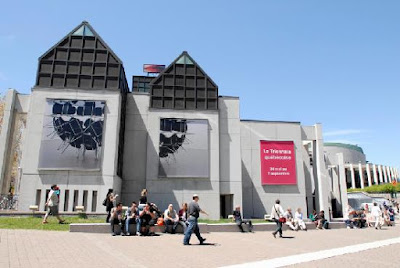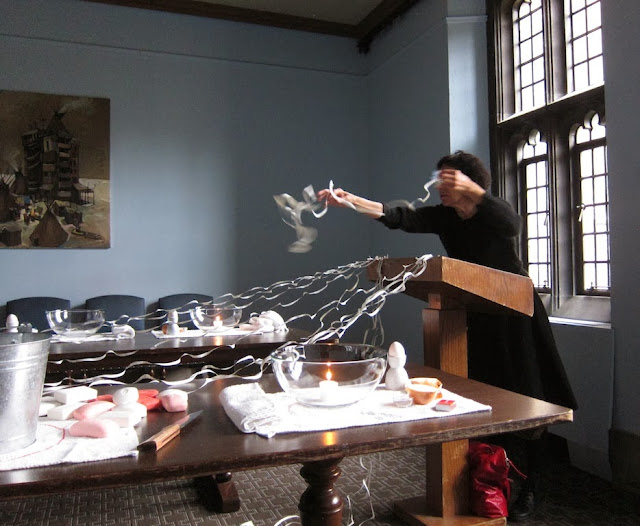By Kate Barry
Our culture is not very good at being with time. There is a tendency to ‘kill’ time, or not to be aware of time —a sense that it’s oppressive. We are also fearful of time passing, of the aging process. Of import is attending to what we’re going through rather than hiding from it, escaping from it or seeking diversion from it.
How do artists use time as a medium to create live performance? How does long-duration performance affect and change the role of the spectator? Typically an audience will come and go during a long-duration performance, and in spite of the fact that most audience members won’t experience the entirety of the performance, the question for both artist and audience remains the same: what happens when time becomes palatable and visceral?
For the 2014 installment of FADO’s Emerging Artists Series we have created a framework for the direct exploration of the medium of time by challenging artists to create a durational performance of a minimum of 6-hours and up to 4-days long. The call for submissions brought us the work of five female artists from Toronto, Montréal, and Ottawa: Arkadi Lavoie Lachapelle, Emma-Kate Guimond, Jessica Karuhanga, Anthea Fitz-James and Rah. Their individual practices were loosely knitted together by themes of ritual, repetition, and language.
As a curator, I am absorbed by the socio-political content of the works of these artists in relation to the female body. In her book, Radical Gestures: Feminism and Performance Art in North America (2006), Jayne Wark referred to a category of literature on performance art that takes the body as its focus. She discusses how issues of subjectivity, identity, gender, and race are explored by female performers as a form of artistic language to express ideas through an in depth communication with their audience. I am concerned with how the female body is negotiated by artists in pop culture, art history, and through performance and live art. I wonder, how is meaning produced through social relations that are marked, or performed, on the body? I am fascinated by how the five artists in 11:45PM use their bodies as metaphors for psychic, cultural, and institutional codes and signifiers ranging from race to gender to sexuality, to class and ability.
Arkadi Lavoie Lachapelle
In her performance 6hours 6minutes and 6seconds Arkadi Lavoie Lachapelle explores the idea of superstition in relation to her body and everyday domestic objects that had been deemed “evil.” During the performance, Lachapelle manipulates the so-called evil objects in a kind of cultural alchemy, transforming each object symbolically through a series of interactive gestures such as balancing them on her body. In doing so, the objects morph from being perceived as inherently evil, to becoming objects with “the right to exist”, as Lachapelle states. She draws from the approach of artists such as Esther Ferrer and Boris Nieslony, whose practices share the desire to mediate between the body, materiality, and the otherworldly. The objects in Lachapelle’s performance have been either anonymously donated by people in Toronto, or have been collected from Montréal addresses with 666 in the street number. Each object is wrapped up and waiting in the gallery space. Not knowing what the objects are prior to the performance infuses each object/body relationship with suspense and curiosity. What is intriguing about Lachapelle’s performance is that her body is implicated in these questions of good and evil. In some religious lore, the human body itself can possess the ‘mark of the devil’. In the height of the Inquisition marks such as moles, scars, birthmarks, skin tags, supernumerary nipples, and blemishes indicated that the individual was a witch. Even today, the derogatory slang for menses is “the curse.” In 6 hours 6 minutes 6 seconds, Lachapelle uses a precise measure of time to search for equilibrium between her body and the object, while creating an elaborate ritual of good and evil.
Emma-Kate Guimond
In digestion/liquidation, Guimond formulates task-based actions utilizing the substance of milk to explore the sensations of attraction and repulsion in relation to her body. Audio recordings made during the performance of a single phrase repeated for 60 minutes, create a circular narrative in which meaning is questioned, and then obliterated through repetition. Performing in a dress soaked in milk, Guimond’s investigation brings forth the idea of the abject, specifically with regards to the classic essay, Powers of Horror: An Essay on Abjection by Julia Kristiva (1980). The abject in Kristiva’s writing refers to the fear patriarchal societies construct in relation to the female body and sexuality. In her essay Kristiva talks about those messy and unpredictable aspects of the female body, its (un)pleasant fluids and substances. Guimond’s washing and wearing of her milk-dress makes reference to the female body’s connection to the abject through its bodily fluids such as breast milk, blood, sweat, and spit. In Guimond’s piece she performs an astute tableau of female subjectivity and bodily being through language, audio-recordings, and repetition.
Over 4-days and with the help of members of the public, Jessica Karuhanga braids herself long hair. Radically long hair. Woven together with her natural hair, the growing trail and physical weight of this new hair will eventually effect and impair Karuhanga’s mobility. She explains, “This gesture will highlight the ritualistic and repetitive aura of braiding hair particularly for women of African descent who have a penchant for actively and passively participating in these transformations.” In The trip, and the fall, and the lost heap of longing hair is a powerful and forceful metaphor signifying the artist’s experience with the rituals of beauty and consumption. During the performance a video plays from a laptop, a home video of Karuhanga’s childhood, showing her mother braiding her sister’s hair. Personal grooming, and hair weaving and braiding, act as a site for female bonding between mother and daughter, and between women. Karuhanga uses hair as a signifier for the socio-political and racial hierarchies formed in personal relationships between family members, friends, as well as the racial hierarchies found in pop culture and in the canon of art history. Karuhanga creates a performance where her own hair is racialized and eroticized in order to call forth the politics and economies of the beauty industry, while she directly confronts issues of body image, gender, sexuality and race.
Anthea Fitz-James
Unraveling the Daughter’s Disease: Secrets, Knitting and the Body tells the story of Fitz-James’ Great-Aunt Pearl’s incarceration through textile and sound. Throughout the 2-days of her performance, Fitz-James unravels the sweater she is wearing while simultaneously re-knitting the yarn into a new clothing object. This ‘embodied-knitting’, as Fitz-James describes it, is traditionally a domestic act, but in her performance it becomes a radical gesture of resilience and strength. During the performance, audio-recordings played on a loop from speakers scattered throughout the space tell the story from the perspective of different family members. The stories weave together the voices of her mother, her aunt, and her sister as they tell the story of one woman’s incarceration, which still affects the family today. Unraveling the Daughter’s Disease: Secrets, Knitting and the Body attempts to offer insight into how anxiety and trauma is passed on through generations and performed on the body.
Rah
Rah’s performance seeks to demonstrate her confidence in, and personal struggle with her identity as an Iranian-Candian woman. In Ululation, she responds to the recent political debate and discussion surrounding the province of Québec’s latest encroachment on individual rights to religious expression through its attempt to ban religious symbols in the workplace. During her performance, Rah wraps herself in a black Chador, a garment worn by woman from Islamic countries to show religious affiliation. She unravels the Chador as she rolls across the gallery floor in a gesture of physical endurance and political resistance. As she unravels herself from the garment’s cocoon-like enclosure, she reveals herself to be wearing a traditional dress worn by woman in Shomal in the northern regions of Iran. Leaving a trail of clothes throughout the gallery as she dresses and undresses, the artist continuously ululates — a sound created by moving the tongue rapidly back and forth repetitively to make a sharp noise. Ululation represents a celebration, but it can also be expressed during times of mourning and sadness. In Ululation Rah’s gestures of concealment and removal, silence and noise, action and stillness, act as a metaphors for personal agency that respond directly to institutional codes that discriminate against people based on their religion, race and class.
The performance projects in 11:45PM explore ritual and temporality, and themes ranging from the supernatural to the transformative. The title of this series refers to a suspended moment in time as a way to highlight the importance of being in the moment and allowing oneself to fully experience a work of art. Or from the perspective of the artist, when creating a performance it refers to the exacting and concentrated focus that is needed to carry out a series of ritualized actions over a long-duration, both suspending and performing the everyday. 11:45PM also draws ones attention to that magical hour of midnight where anything can happen.
****
11:45PM: FADO's Performance Art Centre Emerging Artist Series.
Curated by Kate Barry
MARCH 8 TO 29, 2014 Xpace Cultural Centre, 2-303 Lansdowne Avenue
Unraveling the Daughter’s Disease: Secrets, Knitting and the Body by Anthea Fitz-James, Saturday March 8, 12—6 PM, Sunday March 9 and 1—5 PM, Sunday March 9.
digestion/liquidation by Emma-Kate Guimond, Sunday March 16, 12—8 PM
The trip, and the fall, and the lost heap of longing by Jessica Karuhanga, Wednesday March 19 to Saturday March 22, 1—5 PM DAILY
666 by Arkadi Lavoie LachapelleFriday March 28, 6 PM—12 AM
Ululation, by Rah, Saturday March 29, 12—6 PM
OTHER EVENTS
Thursday March 13, 7 PM FREE, In Time with a Body: Duration as a Performance Practice Artist talk by Paul Couillard
PANEL DISCUSSION: Saturday March 29, 6:30 PM FREE, What Happens After Midnight: Artists Panel Moderated by Tanya Mars!
For more on the Emerging Artist Series and to read the artists Bios, please visit FADO's website: http://www.performanceart.ca/index.php?m=program&id=272
All images and photographs are copyright, 2014.
For more information on FADO Performance Art Centre, please visit the website:


















